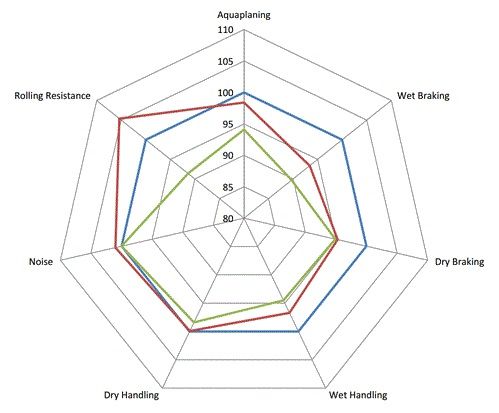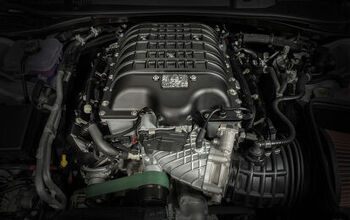Tips and Advice: The Case for OEM Replacement Tires
The first thing that many people do when their new car is ready for its first set of replacement tires is to ditch them for something else. Whether that’s a tire with a high tread mileage guarantee, an ultra-grippy tire, or the cheapest thing they can find, few people actively seek out the exact same tires that their vehicle came with from the factory.
If OEMs could have just selected the best-rated tire from the Tire Rack website, or asked people on a forum what they preferred, and called it a day, wouldn’t they have done that? If you think you’re smarter than an entire team of OEM engineers, then go ahead and slap on that 80,0000-mile-guaranteed set of tires. But, you will want to understand what you might be giving up in the process.
The first thing that we all need to understand is that tire design is largely a balance of trade-offs. You don’t get low rolling resistance without giving up grip. Likewise, you may have to give up tread wear to gain more snow traction. If you’ve seen a spider chart, these are a good way to compare tire attributes for their tradeoffs, but its rare (or expensive) that a tire enlarges the overall area of the chart. That is exactly what the OEMs are pushing the tire manufacturers to achieve, though.
The second thing to understand is that tires are the largest tuning element on the chassis for ride, steering, handling, acceleration, and braking. Literally everything that the vehicle does in regard to its motion is filtered through the tires. Therefore, it is critical that tires are tuned to the vehicle and the vehicle is tuned to the tires.
Changing out the OEM tires is undoing an extensive amount of tuning and development work that cost the OEMs hundreds of thousands — if not millions — of dollars to complete. The process started with vehicle program leaders determining functional attribute targets for the vehicle. From there, engineers worked with tire manufacturers to develop the tires. While “off-the-shelf” tires may sometimes be selected, in most cases the tires are tuned specifically for the vehicle.
With targets in hand, the tire manufacturers would produce several versions of what look like identical tires and submit them to the OEM, along with their internal test data. These would vary in certain ways, sometimes emphasizing one attribute at the expense of another. Upon testing on the vehicle, the OEMs would either select a submission to proceed forward with or request additional revisions. The final tire tuning must be done quite early in the development process, as the rest of the vehicle tuning will be built up around it.
There are often several tire developments for a single vehicle platform for purposes of offering multiple wheel diameters, differing performance attributes for various trim levels, or just to avoid single-sourcing. If there is only one tire for a car and that production plant has a problem, it could shut down an entire vehicle assembly line.
With the tires selected, the OEMs can proceed with development and tuning of the rest of the vehicle around them. While the vehicle dynamics areas of ride, steering, and handling might be most obviously impacted, there are many other functional areas that are tuned around the tires. Braking performance, fuel economy calculations, and powertrain tuning are all impacted. The “active chassis” group will be developing the stability control, ABS, and traction control around the tires, as will the ADAS (advanced driver-assistance systems) group. The NVH (noise, vibration, and harshness) and durability groups will also be conducting their work around the tires.
As a former vehicle dynamics performance engineer for FIAT Chrysler Automobiles, I want to give you a glimpse into how specific vehicles are tuned around the tires. One of the platforms that I had responsibility for was the Pacifica, which had eight unique tires across 17, 18, and 20-inch wheels. Between gas, plug-in hybrid, Waymo, and the new Voyager, there were nine unique damper (shock) tunings to accommodate the ride characteristics of each car riding on each tire for their intended audience. Consider for a moment that, from a ride perspective, a tire is essentially an undamped spring. You can then see how varying that component would affect things such as impact harshness and shake and how that would need to be accounted for in the damper tuning.
In regard to steering, almost every tire had a unique electronic power steering calibration for its application in each model variant. I count 13 by memory and that is without variable steering modes. Each tire possesses unique traits as to how they respond to an input and build force to move the car. In general, it was desired to make all the packages feel roughly the same in terms of steering. However, certain packages varied slightly due to purpose or market.
Based on how the tires differed, changes to EPS tuning were usually required in a few areas of the calibration. The “on-center” feel, or how “positively” the car would steer straight-ahead, was critical to driving comfort, especially over long distances. The response characteristics of the tire would alter the linearity of the effort build in the wheel as the driver steered into a corner. In other terms, as you steer, you want the wheel to communicate with a continuous build in effort as you turn harder. Not having the effort build well-matched to the tire and vehicle response could result in a car feeling anywhere from nervous and hyper-active to sluggish and unwilling to turn.
So, if you value the performance and feel of your car as it came new from the factory, it would behoove you to replace your tires with the original ones when they’re due for it. And, not just the same brand and model, but the exact OEM tire that was tuned for your car. The aftermarket replacements look the same, but if you’re not buying the OEM part from a dealership, it is not likely to be the same OEM tuning.
Even if you’re not a particularly perceptive driver and you wouldn’t notice a relatively small change in something like steering feel, think about how a tiny bit of extra driving fatigue might accumulate over the course of the life of those tires. Or, how that extra 10 feet of stopping distance might not be a big deal until the moment that you need it.
Now, here’s the big caveat for everyone screaming at me right now. The exception is for those who desire a big improvement of a particular attribute of the vehicle’s performance and are willing to trade off many known and unknown factors in order to achieve it. For example, for maximum traction, one might buy a dedicated snow tire or a track-focused tire with the understanding that tread wear, NVH, fuel economy, etc will be significantly impacted. Others may still go ahead and buy the cheapest or longest-lasting tire that they can, but I caution against that. It isn’t worth undoing all the work that made your vehicle what it is and degrading something that cost tens of thousands of dollars in order to save a couple hundred.
Changing out the tires is almost akin to changing the engine in the car. You can do it, but you’d better know exactly what you’re doing, because the whole car was designed around it. If you’re satisfied with the performance of your vehicle, stick with the OEM tires when it comes time to replace.
[Images: FCA, Michelin]
Following 10 years in Toyota's Production Engineering division, Anthony spent 3 years as a Vehicle Dynamics Engineer for FCA. From modest beginnings in autocross, he won a NASA SpecE30 National Championship and was the 2017 Pirelli World Challenge TC Rookie of the Year. Aside from being a professional racecar driver, he is a private driving coach and future karaoke champion.
More by Anthony Magagnoli
Latest Car Reviews
Read moreLatest Product Reviews
Read moreRecent Comments
- W Conrad I'd gladly get an EV, but I can't even afford anything close to a new car right now. No doubt if EV's get more affordable more people will be buying them. It is a shame so many are stuck in their old ways with ICE vehicles. I realize EV's still have some use cases that don't work, but for many people they would work just fine with a slightly altered mindset.
- Master Baiter There are plenty of affordable EVs--in China where they make all the batteries. Tesla is the only auto maker with a reasonably coherent strategy involving manufacturing their own cells in the United States. Tesla's problem now is I think they've run out of customers willing to put up with their goofy ergonomics to have a nice drive train.
- Cprescott Doesn't any better in red than it did in white. Looks like an even uglier Honduh Civic 2 door with a hideous front end (and that is saying something about a Honduh).
- Kwik_Shift_Pro4X Nice look, but too short.
- EBFlex Considering Ford assured us the fake lightning was profitable at under $40k, I’d imagine these new EVs will start at $20k.





































Comments
Join the conversation
One more thing. The "low bidder" comment has been thrown around here. That's not quite the case. Tires are round and black. It's hard to get people to pay extra for your tires. One of the ways that tire manufacturers get you to do this, is by getting a fitment in an oem application. This only comes if your tire is an oem to begin with. A lot of people, and by that mean over 30%, will go back to what the car was originally fitted with. This is why a lot of tire manufacturers will actually LOSE money on an oem fitment. So, no, price initially is fairly set evenly across the suppliers. They all have to meet the same criteria.
That's fine, but in my case the tires selected for my (hybrid) car through this "exhaustive and expensive" evaluation had abysmal wet road traction. The "finger of God" experience one gets when stability control activates was more like both hands pushing, this on a familiar road in a manner of driving that I often had done without drama. And that's the truth.